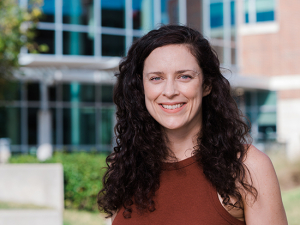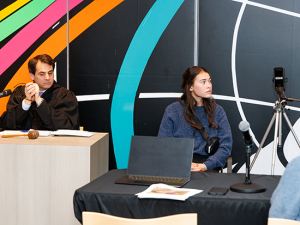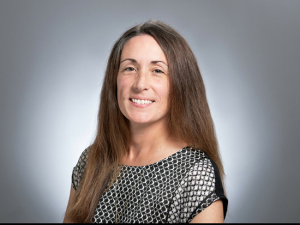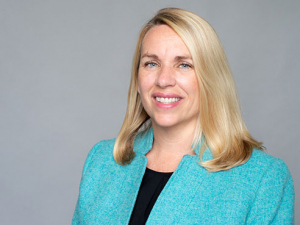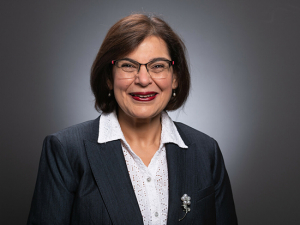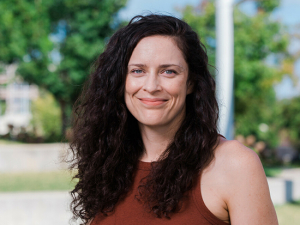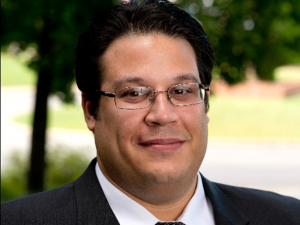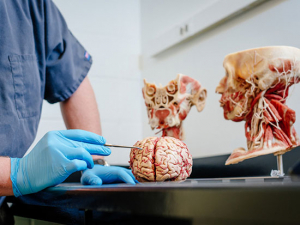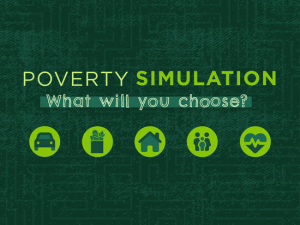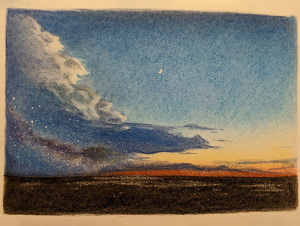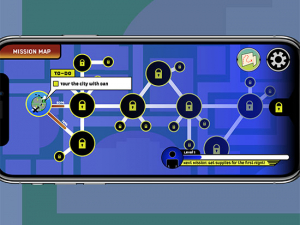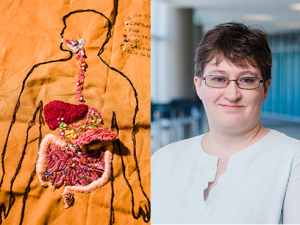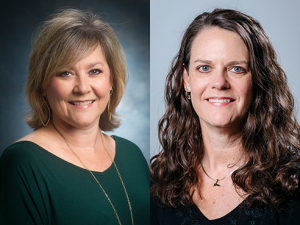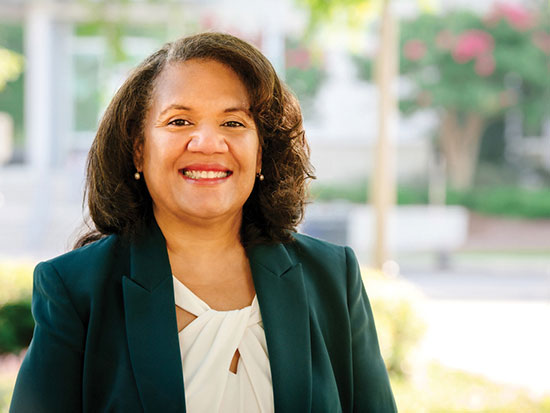 College of Arts and Sciences Dean Kecia Thomas, Ph.D., launched the Building a Multicultural Curriculum grants program in fall 2020. “The canons of our disciplines have often not attended to the contributions of women and people of color; they were erased," she said. "Today we know better, and it is our responsibility, through our curriculum, to provide our students with more accurate information."In the waning days of August 1914, as Allied soldiers retreated before German armies in Europe, the Tuskegee Institute Singers traveled from Alabama to Camden, New Jersey, to record one of the most famous songs from another war: the fight for freedom. The group’s rendition of the spiritual “Go Down, Moses,” used by Harriet Tubman as a signal on the Underground Railroad and banned on Southern plantations as African Americans struggled to escape from slavery, now is preserved by the Library of Congress.
College of Arts and Sciences Dean Kecia Thomas, Ph.D., launched the Building a Multicultural Curriculum grants program in fall 2020. “The canons of our disciplines have often not attended to the contributions of women and people of color; they were erased," she said. "Today we know better, and it is our responsibility, through our curriculum, to provide our students with more accurate information."In the waning days of August 1914, as Allied soldiers retreated before German armies in Europe, the Tuskegee Institute Singers traveled from Alabama to Camden, New Jersey, to record one of the most famous songs from another war: the fight for freedom. The group’s rendition of the spiritual “Go Down, Moses,” used by Harriet Tubman as a signal on the Underground Railroad and banned on Southern plantations as African Americans struggled to escape from slavery, now is preserved by the Library of Congress.
The song, and the singers, have much to teach today’s students, says Reginald Jackson, Ed.D., assistant professor in the Department of Music and director of the UAB Gospel Choir. "It's a horrible story, the story of slavery, but the people had a will to survive, and they would use music and the arts as a way of survival," Jackson said. "The spirituals came out of this slave experience. They served many purposes, but they always spoke to the future, of how we are going to get out of this. Through all the struggles and trials and resistance to racism and oppression over the years, African Americans found in music a source of inspiration to overcome, and that influence has affected everything from jazz to blues to gospel to today's popular music. It's really a powerful thing to realize the influence of African American music on American culture."
Jackson and Patrick Evans, chair of the Department of Music, had been talking about adding a course on this topic to the department’s catalog. Then, this past fall, they heard about the inaugural Building a Multicultural Curriculum grants program from the College of Arts and Sciences. Evans encouraged Jackson to apply, and his proposal for African American Music from 1619-Present was one of eight faculty projects selected. Other courses include Social Justice and Pop Culture, Themes in Lit with a Latina-o-x American Identity Focus, Our Histories: Documentary Film and Public History in Birmingham, and Equity and Inclusion in Research and the Workplace. (See full list of courses and faculty recipients below.)
The awards will enable faculty to develop new classes or revise existing classes to support students' diversity awareness and build their multicultural competence, said Dean Kecia Thomas, Ph.D. "We are preparing students to be leaders in a society that is far more diverse in regard to opportunities for career development than our parents' and grandparents' generations," Thomas said. "Our students need to understand the history and contributions of these groups to effectively be good citizens. The canons of our disciplines have often not attended to the contributions of women and people of color; they were erased. Today we know better, and it is our responsibility, through our curriculum, to provide our students with more accurate information.”
UAB’s strategic goals
Providing a socially conscious education to diverse students is the central strategic goal of the Education pillar of Forging the Future, UAB's strategic plan. A diverse curriculum also contributes directly to shifting Forging the Future's key metrics, including student retention and the graduation rate for underrepresented students.
"Our goals are to continue to increase our retention and graduation rates," Thomas said. "And there is research showing that, for ethnic minority groups, the opportunity to see oneself in the curriculum is an important part of engagement. Just one course is sufficient to get students to see themselves and persist in other courses."
Strong faculty interest
CAS already has a strong collection of courses on race and social justice topics, Thomas said — so much so that “my tenure as dean started with a campaign to highlight that fact,” she noted. (See Race and social justice campaign highlights CAS strength below.)
Would faculty have more ideas for new courses or interest in revising existing courses? When the call for proposals for the Building a Multicultural Curriculum grants was announced in fall 2020, Thomas was not sure what the response would be. "There was far more interest than I thought," she said. "We got 18 proposals, which was probably three times the number I expected, and we ended up funding more proposals because of that response. We also gave good feedback to those faculty whose proposals weren't accepted and encouraged them to apply in the future."
The selected proposals are roughly split between new courses such as Jackson's and revisions of previously offered classes. Erin Borry, Ph.D., associate professor in the Department of Political Science and Public Administration, is revamping a class that has not been taught for several years into a new graduate-level course, tentatively titled (In)equity in Public Administration. "The idea is to get students to think about the ways bias influences public policy and policy outcomes and how our own identities and bias shape how we would do our public-service work," Borry said. "Our curriculum touches on anti-discrimination and on diversity and inclusion, but it doesn't take a hard look at how policies and implementation have created or exacerbated inequities. This is important because many of our students will be or already are working on the front lines of government and help provide services to the public."
Growth mindset in biology
Samiksha Raut, Ph.D., associate professor in the Department of Biology, is using her grant to expand the diversity, equity and inclusion content in her Instructional Teaching Practicum course, which she uses to prepare upper-level students to become peer leaders (what she calls Biology Learning Assistants, or BLAs) for her large-enrollment Biology 123/124 classes. Bio 123 is one of those pivotal gateway courses that can either confirm a student’s interest in a STEM career or derail it.
Each BLA is assigned to groups of eight to 10 students. The freshman students in these gateway courses “love being in these peer-led groups; there is no pressure of having a professor around, and they tend to open up around other students — not only to get academic help but general assistance required to navigate a successful college experience,” Raut said. “My hope is that it eventually leads to the creation of a wonderful learning community enabling the students to get more one-on-one assistance to remain in STEM fields."
The one-credit Instructional Teaching Practicum course is the first academic service-learning course at UAB designated by the university’s Office of Service Learning and Undergraduate Research. Raut teaches the BLA class with a two-pronged approach: equipping students with cutting-edge pedagogical skills and imparting training on diversity, equity and inclusion issues in STEM. The latter is important as BLAs lead a group of eight to 10 students and “hence, it is imperative to address issues like privilege, stereotype bias, gender equality, intersectionality and more to create a positive learning environment in these groups,” Raut said. “I am now excited to introduce these issues in the context of social justice and how they relate to STEM with the multicultural grant. Students learn about these issues in social-science classes but never gain an insight into how these issues are related to STEM and to their future professional careers. I am doing the job of a bridge builder.”
Many of the BLAs “come from educationally privileged backgrounds and high schools,” Raut noted. “On the other hand, many of our students in our large introductory biology classes are coming from high schools where they did not have access to Advanced College classes or may have never encountered learning opportunities that stimulate critical thinking skills or had access to summer bridge programs that got them involved in research opportunities.” Above all, she says, “many of these students belong to under-represented minority groups and are often first-generation college students who never had a role model in their own families to promote the growth mind-set required to navigate college.” As she works with BLAs, “we talk about what it means to be under-represented in science and the issue of having a growth mindset versus a fixed mindset," Raut said.
"I have had these conversations with faculty at prior institutions," Thomas said. "Sometimes we are not sensitive to the power dynamics that enter into our classrooms, especially when the students are not represented in the faculty or in the field they are studying. It is really important for teaching assistants and faculty to be mindful of their language and have a growth mindset: 'This is hard, but you can do it. If we work together, everyone can succeed,' rather than 'STEM is really hard — are you sure you want to do that?' Students from different economic and racial backgrounds hear those messages."
Safe space and strategies
Courses in diversity and inclusion are increasingly required by accreditation bodies, which see them as essential to training practitioners in their fields, Thomas added.
“Our graduates are going into more diverse work environments and studying more diverse samples,” said Olivio Clay, Ph.D., associate professor in the Department of Psychology, who is developing a graduate course titled Diversity, Equity and Inclusion in Research and the Workplace with his grant. “Many of them are interested in health disparities and social determinants of health. We wanted to give them an environment where they could learn more about interacting with people from diverse backgrounds and give them a safe space to ask questions and address concerns.”
The course also aims to “give students strategies they can use to recruit diverse participants,” Clay said. “A lot of times in research we hear the same thing again and again: Go to churches, barber shops, hair salons. But there are a lot of individuals who might be reached by our research who are being missed. This applies to anyone taking part in research: They don’t just want to see you come and collect their data and head back to your ivory tower. They want to see your face in their community and see that you are willing to be a presence in the community you wish to study.”
Existing courses in the department touch on these issues, Clay said. But “being able to have one course with a true focus on diversity, equity and inclusion that goes across our three doctoral programs here in psychology definitely meets a need. Before they get out there on the job market and start their own labs and research programs, we want to make sure our students have a focus on doing research that is generalizable to the entire population, not just the typical groups that will take part in university research studies.”
The one-credit course, which Clay is piloting this spring, will include speakers specializing in social and health disparities research or serving in leadership positions in equity and diversity at universities around the country. “The funding from the Multicultural Curriculum grant will provide the honoraria for those speakers,” Clay said. “I am really glad the dean has established this program. A friend once told me, ‘If something is important to you, you will set funds aside or time aside to take care of it.’ The same is true at the university level. I am grateful to have a dean who sets aside funds to enable these experiences for our students.”
Building a Multicultural Curriculum will be an annual program, Thomas said. “We probably won’t do the entire college each year going forward. Next year could be arts and STEM, the year after that the humanities and social sciences, and so on. The need persists.”
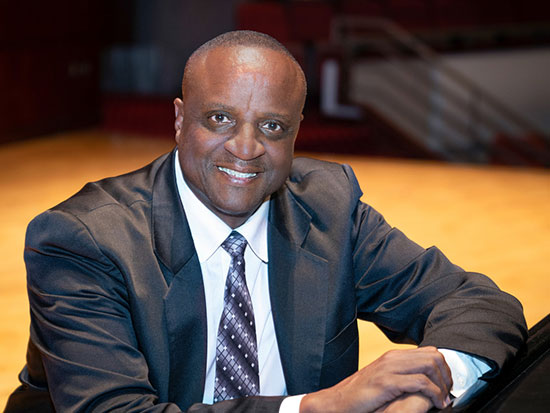 “Through all the struggles and trials and resistance to racism and oppression over the years, African Americans found in music a source of inspiration to overcome, and that influence has affected everything from jazz to blues to gospel to today's popular music. It's really a powerful thing to realize the influence of African American music on American culture.”
“Through all the struggles and trials and resistance to racism and oppression over the years, African Americans found in music a source of inspiration to overcome, and that influence has affected everything from jazz to blues to gospel to today's popular music. It's really a powerful thing to realize the influence of African American music on American culture.” 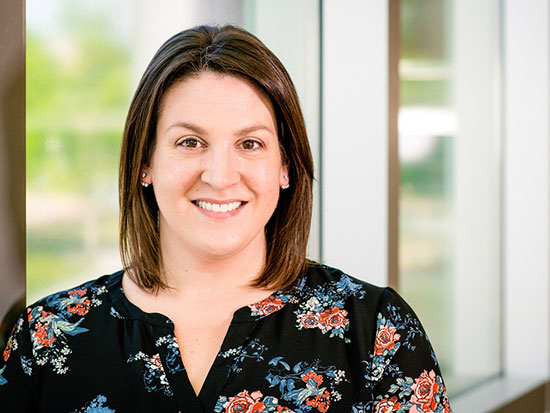 "The idea is to get students to think about the ways bias influences public policy and policy outcomes and how our own identities and bias shape how we would do our public-service work…. This is important because many of our students will be or already are working on the front lines of government and help provide services to the public."
"The idea is to get students to think about the ways bias influences public policy and policy outcomes and how our own identities and bias shape how we would do our public-service work…. This is important because many of our students will be or already are working on the front lines of government and help provide services to the public." 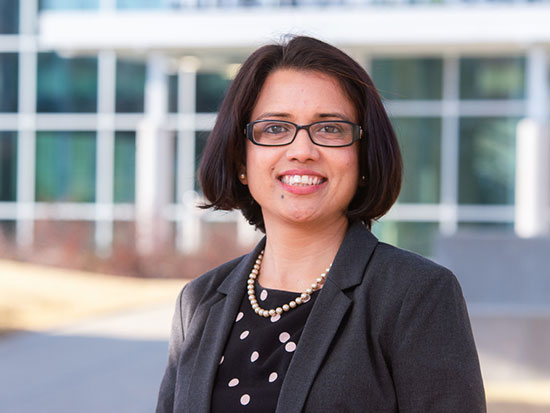 “It is imperative to address issues like privilege, stereotype bias, gender equality, intersectionality and more to create a positive learning environment…. Students learn about these issues in social-science classes but never gain an insight into how these issues are related to STEM and to their future professional careers.”
“It is imperative to address issues like privilege, stereotype bias, gender equality, intersectionality and more to create a positive learning environment…. Students learn about these issues in social-science classes but never gain an insight into how these issues are related to STEM and to their future professional careers.”  “Being able to have one course with a true focus on diversity, equity and inclusion that goes across our three doctoral programs here in psychology definitely meets a need. Before they get out there on the job market and start their own labs and research programs, we want to make sure our students have a focus on doing research that is generalizable to the entire population.”
“Being able to have one course with a true focus on diversity, equity and inclusion that goes across our three doctoral programs here in psychology definitely meets a need. Before they get out there on the job market and start their own labs and research programs, we want to make sure our students have a focus on doing research that is generalizable to the entire population.” 